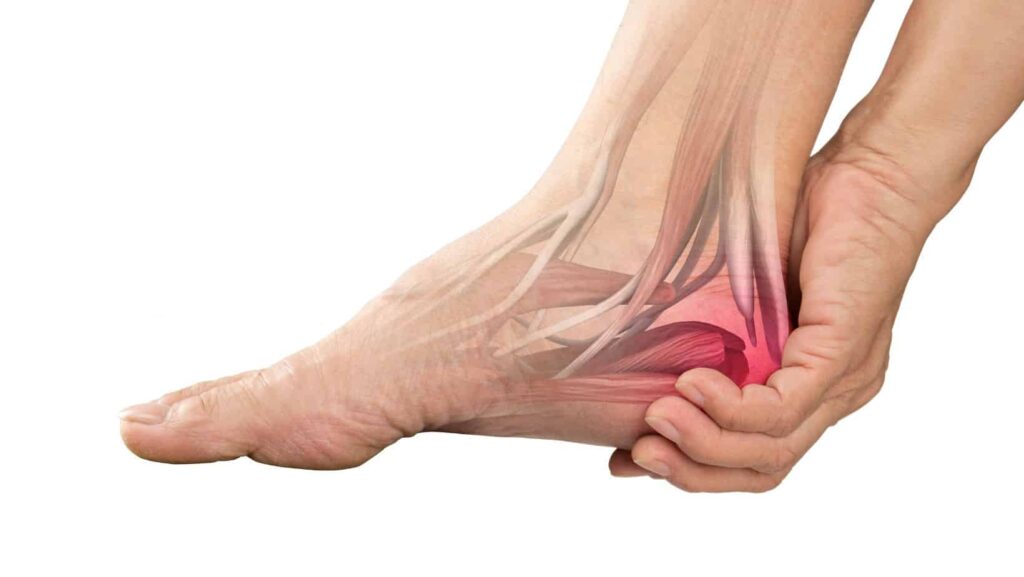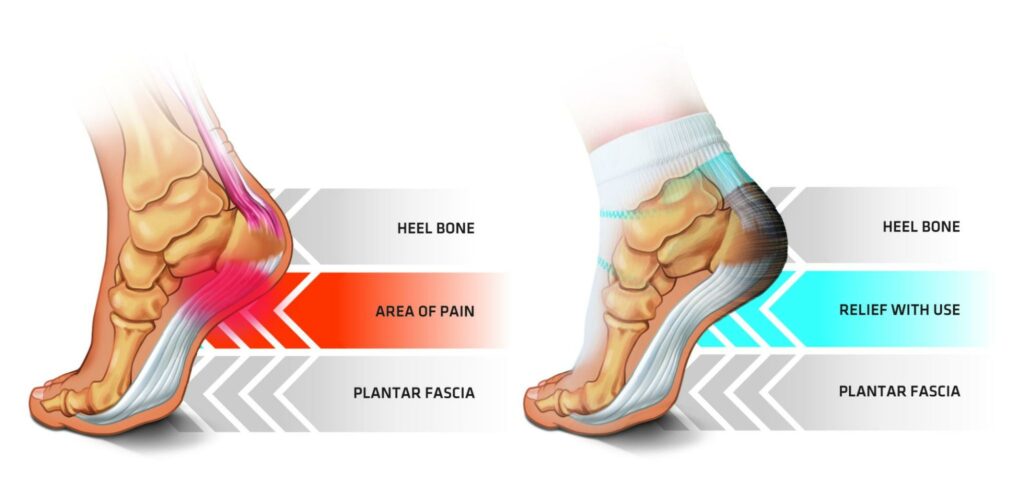A bruised heel or fat pad contusion, also referred to as ‘racer’s heel,’ is a collection of blood in or around the fat pad that cushions our heel bone. It occurs as a result of an injury to the heel pad or the bone itself. Bruised heel affects a significant proportion of adults and an even greater number of adolescents and young athletes globally. 1Bartold S. Heel pain in young athletes. Aust Podiatr. 1993;27:103–105. Generally self-resolving, but if ignored, a bruised heel can become debilitating, prolonging the otherwise shorter rehabilitation period.
It’s crucial to pick and treat a bruised heel on time and to know what we can do to prevent it in the first place. In this article, we aim to make you aware of the pathophysiology, causes, clinical picture, treatment, and prevention of a bruised heel.
Pathophysiology:

The calcaneum or the heel bone – the primary weight-bearing bone of the foot – receives the most stress during jumping, walking, running, and other activities that involve repeated striking. Although under physiological conditions, the sub calcaneal bursa (fluid-filled sac) and the admixture of fat and connective tissue beneath the heel bone absorb the excessive shock that may otherwise injure our heel. But once the magnitude of external force exceeds the heel’s bearing capacity or the shock absorbing mechanism disrupts, the cushioning can no longer protect. This damages the soft tissues, rupturing vessels and causing blood to pool around the heel pad, just beneath the skin, clinically visible as a bruised heel.
Causes of a Bruised Heel:
A bruised heel may arise secondary to an acute, well-defined traumatic event like a fall with landing on the heel, or multiple episodes of constant repetitive stress, especially those with inadequate recovery. We found that 87% of young athletes with posterior heel injuries were involved in running and jumping sports2Micheli LJ, Ireland ML. Prevention and management of Calcaneal Apophysitis in children: An overuse syndrome. J Pediatr Orthop. 1987;7(1):34–38.. While mild injuries can result in a contusion to the heel pad or deep bone bruise, repeated injuries can produce a Calcaneal stress fracture.
Ill-fitting footwear, like flimsy flip-flops or worn-out shoes that strike our heel pad on and off, also contributes to developing a bruised heel. Injuries related to growth 3Malanga GA, Ramirez-Del Toro JA. Common injuries of the foot and ankle in the child and adolescent athlete. Phys Med Rehabil Clin N Am. 2008;19(2):347–71. ix., gait problems, age-related fat pad atrophy, obesity, and impact with uneven surfaces are other causes for a bruised heel.
Symptoms of a Bruised Heel:

A bruised heel manifests as visible discoloration, i.e., ecchymosis, mild to severe swelling(depending upon the underlying cause and its intensity), tenderness upon pressing, and peculiar pain under the heel. The pain is dull, aching, does not radiate, and worsens upon standing or bearing weight. 4Im Yi, T., Lee, G. E., Seo, I. S., Huh, W. S., Yoon, T. H., & Kim, B. R. (2011). Clinical characteristics of the causes of plantar heel pain. Annals of rehabilitation medicine, 35(4), 507-513. You will notice that the symptoms alleviate upon shifting to a non-weight-bearing position. A history of repeated impact to the sole of the foot, such as running or sports training sessions, is usually present.
How to diagnose a Bruised Heel?
A bruised heel can be diagnosed and cured at home. But, if in doubt, don’t hesitate to consult your doctor. A podiatrist or a sports physiologist will take a good history and perform an examination. To diagnose accurately, he will also request your X-ray foot and CT scan. He will devise an effective, holistic plan for your bruised heel treatment.
Differentiating a Bruised Heel from Plantar Fasciitis:

The symptoms of a bruised heel and plantar fasciitis often overlap. What can help you differentiate between the two is the nature of pain. Planter fasciitis typically presents with first-step pain in the morning5Im Yi, T., Lee, G. E., Seo, I. S., Huh, W. S., Yoon, T. H., & Kim, B. R. (2011). Clinical characteristics of the causes of plantar heel pain. Annals of rehabilitation medicine, 35(4), 507-513., which aggravates during periods of rest. Upon starting activity again, the heel feels better. Contrary to this, the pain of a bruised heel is worse during activity, i.e., weight-bearing. It eases upon taking rest. It doesn’t radiate, unlike the pain of plantar fasciitis, which often extends toward the foot’s medial arch. If you still can’t reach a diagnosis, consult your doctor.
Treatment for a Bruised Heel:
A bruised heel will resolve independently if you give it enough time and support to recover. Yes. Unless it’s not plantar fascitis or fractured heel bone, a bruise can easily be treated by applying the conventional ‘PRICE’ principle:
- Protection: Protect your feet from further injury. Discontinue bearing weight on them, particularly for the first few days of trauma.
- Rest: Be it a minor or a deep bruise, your bruised heel needs rest the most. Not giving your heels the due rest can result in something much more serious later.
- Ice: Apply ice packs or immerse your heels in ice water for ten minutes every two hours. This will help settle pain and swelling. As the symptoms improve, you can reduce the duration and frequency of ice pack application.
- Compression: External compression, e.g., by taping bruised heel, provides additional protection. It allows for a speedy recovery.
- Elevation: Elevate the affected foot above the level of the heart whenever possible. It will also improve the swelling.
Treatment aims to reduce pain and swelling and enable you to return to your routine. You can supplement the aforementioned home remedy with physiotherapist-supervised bruised heel stretches 6Tollafield DR, Merriman DT. Clinical Skills in Treating the Foot. London: Churchill Livingstone; 1997. and over-the-counter pain reliever medications.
Preventing a Bruised Heel:
Once all your symptoms have almost resolved and you plan on resuming weight-bearing activities, don’t forget to identify and correct the causative factors7Thomas JL, Christensen JC, Kravitz SR, et al. The diagnosis and treatment of heel pain: A clinical practice guideline-revision 2010. J Foot Ankle Surg. 2010;49(Suppl 3):S1–S19.:
- Wear shoes that fit well and absorb shock better. Consider changing your shoes every six months or when they start wearing out. You can also use heel cups for extra protection.
- Avoid walking barefoot on hard and uneven surfaces.
- Visit a podiatrist or orthopedic physician to assess your foot biomechanics and fix the malalignment. You also need to seek medical advice if symptoms worsen despite the conservative management or if you are not sure about the diagnosis.
- Give your body the nutrition and rest it deserves.
- If overweight, work to attain a healthy BMI.
The same measures give rise to a preventative strategy that we should adopt right away and save ourselves from agony in the longer run.
How long will it take to recover?
Bruised heel recovery usually takes a few weeks if taken good care of. Minor bruises resolve within a few days; deep bruises take one to two weeks. But if you continue working out and don’t give your heel ample time to heal, recovery might take up to a few months. This is serious. An acute injury going on for months triggers chronic inflammation. Consequently, it harms the outer lining of the bone, which then, cant be renewed easily.
Conclusion:
A bruised heel results from an injury to the heel pad or the heel bone. Conventional measures like protection, rest, ice application, compression, and elevation help subside the acute phase. It is important to stay vigilant. Above all, detecting and treating the risk factors timely, is the key to a successful treatment and prevention plan.
Refrences
- 1Bartold S. Heel pain in young athletes. Aust Podiatr. 1993;27:103–105.
- 2Micheli LJ, Ireland ML. Prevention and management of Calcaneal Apophysitis in children: An overuse syndrome. J Pediatr Orthop. 1987;7(1):34–38.
- 3Malanga GA, Ramirez-Del Toro JA. Common injuries of the foot and ankle in the child and adolescent athlete. Phys Med Rehabil Clin N Am. 2008;19(2):347–71. ix.
- 4Im Yi, T., Lee, G. E., Seo, I. S., Huh, W. S., Yoon, T. H., & Kim, B. R. (2011). Clinical characteristics of the causes of plantar heel pain. Annals of rehabilitation medicine, 35(4), 507-513.
- 5Im Yi, T., Lee, G. E., Seo, I. S., Huh, W. S., Yoon, T. H., & Kim, B. R. (2011). Clinical characteristics of the causes of plantar heel pain. Annals of rehabilitation medicine, 35(4), 507-513.
- 6Tollafield DR, Merriman DT. Clinical Skills in Treating the Foot. London: Churchill Livingstone; 1997.
- 7Thomas JL, Christensen JC, Kravitz SR, et al. The diagnosis and treatment of heel pain: A clinical practice guideline-revision 2010. J Foot Ankle Surg. 2010;49(Suppl 3):S1–S19.

